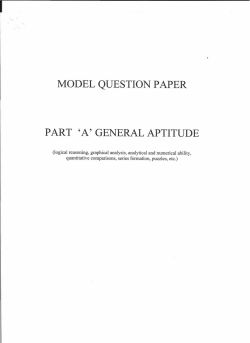
1 The Seven Circles Theorem by Stanley Rabinowitz Alliant Computer Systems Corporation
1 The Seven Circles Theorem by Stanley Rabinowitz Alliant Computer Systems Corporation Littleton, MA 01460 Start with a circle. Any circle. Draw six more circles inside it, each internally tangent to the original circle and tangent to each other in pairs. Let A, B, C, D, E, and F be the consecutive points of tangency of the small circles with the outer circle. We wind up with a set of seven circles as shown in Figure 1. The Seven Circles Theorem says that no matter what sizes we pick for the seven circles (subject only to certain order and tangency constraints), it will turn out that the lines AD, BE, and CF will meet in a point. F F A A B B E E C C D D Figure 1 This remarkable theorem is less than fifteen years old. It shows that there are many beautiful relationships involving only lines and circles still waiting to be discovered. Evelyn, Money-Coutts, and Tyrrell [6] first published this theorem in 1974. Since then, other proofs have appeared (see [5]). The purpose of this article is to give a simple proof of this theorem using only elementary geometry. Since we wish to prove that three lines concur (meet in a point), we start by reviewing what is known about three concurrent lines. Various facts about three concurrent lines in a triangle were known to early geometers (like Heron of Alexandria and Archimedes). They knew that the medians concur and the altitudes concur ([2], pp. 297–298). However, it was not until 1678 that Giovanni Ceva gave a definitive treatment about such lines. For that reason, a line from a vertex of a triangle to a point on the opposite side is called a cevian. Here is a simplified version of Ceva’s Theorem. Reprinted from the Pi Mu Epsilon Journal, 8(1987)441–449 2 Ceva’s Theorem. Let D, E, and F be points on sides BC, CA, AB, respectively, of triangle ABC. Then cevians AD, BE, CF concur if and only if AF · BD · CE = F B · DC · EA. A H F B A G F E E P P C D B Figure 2 D X C Figure 3 Proof. (i) Suppose AD, BE, CF meet at a point P . Extend BE and CF until they meet the line through A that is parallel to BC at points G and H respectively (see Figure 2). From similar triangles, we get the proportions: DC/HA = P D/AP AG/BD = AP/P D AE/EC = AG/BC BF/F A = BC/HA. and Multiplying these together gives us the desired result. (ii) Conversely, suppose AF · BD · CE = F B · DC · EA. Let BE meet CF at P and let AP meet BC at X. Then by part (i), we have AF · BX · CE = F B · XC · EA. Dividing these two results gives BX BD = . DC XC 3 If X does not coincide with D, then without loss of generality, assume X lies on segment DC (see Figure 3). Then BD < BX and DC > XC. Consequently, BD/DC < BX/XC, a contradiction. Thus X coincides with D. Remark. If we are a little more careful about signs and use directed segments, Ceva’s Theorem can be generalized to work for any points D, E, F on the sides of the triangle or on the extensions of these sides (see [2]). However, we will not need this extended result here. Before we can approach the Seven Circles Theorem, we must know something about when three chords of a circle concur. Coxeter [3] gives a criterion that we will call Ceva’s Theorem for Chords. Both the statement and proof are remarkably analogous to Ceva’s Theorem. Ceva’s Theorem for Chords. Let A, B, C, D, E, and F be six consecutive points around the circumference of a circle. Then chords AD, BE, CF concur if and only if AB · CD · EF = BC · DE · F A. A B P E F C C E D X D Figure 4 Figure 5 Proof. (i) Suppose AD, BE, CF meet at a point P (see Figure 4). From similar triangles, we get the proportions: and AB/DE = P A/P E EF/BC = P F/P B CD/F A = P C/P A P C/P E = P B/P F . Multiplying these together gives us the desired result. 4 (ii) Conversely, suppose AB · CD · EF = BC · DE · F A. (1) Of the three arcs, ABC , CDE , EF A , at least one must be smaller than a semicircle. Without loss of generality, assume arc CDE is smaller than a semicircle. Let BE meet CF at point P and let AP meet the circle again at point X (which must lie on arc CDE ). By part (i), we have AB · CX · EF = BC · XE · F A. This combined with (1) gives CD CX = . DE XE If X does not coincide with D, then without loss of generality, assume X lies on arc DE (see Figure 5). Then CD < CX and DE > XE. Consequently, CD/DE < CX/XE, a contradiction. Thus X must coincide with D. Before proceeding to the Seven Circles Theorem, we need one preliminary result. Lemma. Let two externally tangent circles, P and Q, be internally tangent to circle C at points A and B respectively. If the radii of circles C, P , and Q are R, p, and q, respectively, then AB 2 /4R2 = (p/(R − p)) · (q/(R − q)). C E D P M A Q B Figure 6 Proof. Let circles P and Q be tangent at point M . Extend AM and BM to meet circle C again at points D and E respectively. Identify the names of circles with their centers. Draw CD and CE. (See Figure 6.) Draw P Q which must pass through M . 5 CA = CD implies CAD = CDA. P A = P M implies P AM = P M A. Therefore, P M A = CDA and CD P M . Similarly, CE QM . But P M Q is a straight line, so therefore DCE is a straight line also. Note also that EBA = EDA (since both mea sure half of arc EA ). We thus have three pairs of similar triangles: M DE ∼ M BA, BM Q ∼ BEC, and AM P ∼ ADC. Then AB/DE = M A/M E = M B/M D. Since DE = 2R, we have MA MB MA MB P A QB p q AB AB · = · = · = · = · . 2R 2R ME MD MD ME CP CQ R−p R−q We are now ready to prove our main result. The Seven Circles Theorem. Let A0 , A1 , A2 , A3 , A4 , A5 be six consecutive points around the circumference of a circle O. Suppose circles can be drawn internally tangent to circle O at these six points so that they are also externally tangent to each other in pairs (that is, the circle at Ai is tangent to the circle at Ai−1 and the circle at Ai+1 , where subscripts are reduced modulo 6). (See Figure 7.) Then segments A0 A3 , A1 A4 , and A2 A5 concur. A4 A3 A5 A6 A2 A1 Figure 7 Proof. Let the radius of circle O be R and let the radius of the circle at Ai be ri . Let us express Ai Ai+1 in terms of ri and ri+1 . By the lemma, we have Ai Ai+1 = 2Rf (ri )f (ri+1 ) 6 where f (r) = r/(R − r) and the subscripts are reduced modulo 6. Thus A0 A1 · A2 A3 · A4 A5 = 8R3 f (r0 )f (r1 )f (r2 )f (r3 )f (r4 )f (r5 ) = A1 A2 · A3 A4 · A5 A0 . So by Ceva’s Theorem for Chords, A0 A3 , A1 A4 , and A2 A5 must concur. The Seven Circles Theorem is true for more general configurations than the one described above. For example, Figure 8 shows the case where the six circles are externally tangent to the original circle rather than being internally tangent. A F B E C D Figure 8 This case can be proved in a manner similar to the previous proof. Using Figure 9, we can derive the formula AB 2 /4R2 = (p/(R + p)) · (q/(R + q)) whose proof is analogous to the proof of the preceding lemma. Here, circles P and Q are externally tangent to circle C. R, p, and q denote the radii of circles C, P , and Q respectively. It then becomes clear that A0 A1 · A2 A3 · A4 A5 = 8R3 g(r0 )g(r1 )g(r2 )g(r3 )g(r4 )g(r5 ) = A1 A2 · A3 A4 · A5 A0 where g(r) = r/(R + r). 7 E C B Q D A M P Figure 9 In fact, the Seven Circles Theorem is even more general than this. The six points of tangency need not occur successively along the circumference of the original circle. Two such cases are shown in Figure 10. A proof for the general configuration can be found in [6]. A1 A1 A4 A3 A3 A5 A2 A0 A0 A2 A5 A4 Figure 10 An interesting subtlety occurs when trying to formulate the theorem for the most general configuration. After starting with an initial circle, C, and drawing five circles, A1 , A2 , A3 , A4 , and A5 tangent to C and tangent to themselves in succession, it becomes 8 necessary to draw a sixth circle tangent to C, A5 , and A1 . However, in general, this can be done in two ways (see Figure 11). Of the two choices, one satisfies the conclusion of the Seven Circles Theorem and the other doesn’t. In this sense, the Seven Circles Theorem may be thought to hold only 50% of the time. Y A1 A5 X Figure 11 Exercises. We conclude with a few exercises to allow readers to try some related problems. 1. A circle is inscribed in triangle ABC. The points of contact with sides BC, CA, and AB are D, E, and F respectively (see Figure 12). Prove that AD, BE, and CF concur. (The point of concurrence is known as the Gergonne point of the triangle; see [2], page 160.) Show further that the conclusion still holds if the circle is replaced by an ellipse. D C E A B F A E F B G D Figure 12 C L H K I J Figure 13 2. Let ABCDEF GHIJKL be a regular dodecagon (see Figure 13). Prove that diagonals AE, CF , and DH concur. (For a proof see [10].) 9 3. Three circles are situated as shown in Figure 14 so that each meets the others in two points. Prove that AD, BE, CF concur and that AF · BD · CE = F B · DC · EA. (This result is due to Haruki, see [9].) A A F F B E B D E C D C Figure 14 Figure 15 4. Let ABCDEF be a hexagon circumscribed about a circle, as in Figure 15. Prove that AD, BE, CF concur. (This is a special case of Brianchon’s Theorem, see [4], p. 77.) 5. Let P be a point inside pentagon ABCDE such that lines AP , BP , CP , DP , EP meet the opposite sides at points F , G, H, I, and J as shown in Figure 16. Prove that AI · BJ · CF · DG · EH = BI · CJ · DF · EG · AH. (See [8], page 67.) A I H B P J E C G F D Figure 16 10 References [1] [2] [3] [4] Giovanni Ceva, De Lineis Rectis se Invicem Secantibus. . Milan: 1678. Nathan Altshiller Court, College Geometry. Barnes and Noble. New York: 1960. H. S. M. Coxeter, “Problem 527”, The Mathematics Student. 28(1980)3. H. S. M. Coxeter and S. L. Greitzer, Geometry Revisited. Random House. New York: 1967. [5] H. Martyn Cundy, “The Seven-circles Theorem”, Math. Gazette. 62(1978)200–203. MR 80c:51019. [6] Cecil John Alvin Evelyn, G. B. Money-Coutts and J. A. Tyrrell, The Seven Circles Theorem and Other New Theorems. Stacey International. London: 1974. MR 54 #1066. [7] Cecil John Alvin Evelyn, G. B. Money-Coutts and J. A. Tyrrell, Le Th´eor`em des Sept Cercles. Collection Formation des Maitres en Math´ematique, No. 21 Editions CEDIC. Paris: 1975. MR 57 #10551. [8] Howard Eves, A Survey of Geometry, revised edition. Allyn and Bacon, Inc. Boston: 1972. [9] Ross Honsberger, “The Butterfly Problem and other Delicacies from the Noble Art of Euclidean Geometry”, Two Year College Math. Journal. 14(1983)6. [10] Stanley Rabinowitz, “Problem F–4, When Diagonals Concur”, The AMATYC Review. 6(1985)61. [11] J. F. Rigby, The Geometry of Cycles and Generalized Laguerre Inversion, in The Geometric Vein, The Coxeter Festschrift, edited by Chandler Davis, Branko Gr¨ unbaum, and F. A. Sherk. Springer Verlag. New York: 1981, pp. 355–378. [12] J. A. Tyrrell and M. T. Powell, “A Theorem in Circle Geometry”, Bull. London Math. Soc. 3(1971)70–74.
© Copyright 2025





















